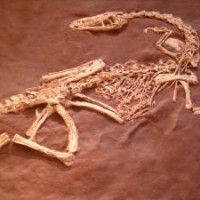
Following the Flood, the world was dramatically changed. The Ice Age was a period of glacial activity that covered approximately 30 percent of the earth; today about ten percent is covered with ice. After the Flood, it took approximately 500 years to cover the land with ice and another 200 years to melt the ice back to the existing areas we see today. The cause of the Ice Age was the Flood itself with its ensuing seismic upheavals and volcanic activity. Volcanic dust and particles would have been in the atmosphere for years following the Flood. Ice core samples show this. With the volcanic debris in the air, sunlight would be reflected back into space, causing cool temperatures over the land masses. Warm water would evaporate and snow heavily over poles, thereby causing the Ice Age. Consequently, the Genesis 11 genealogy shows the lifespan of humans dropping off significantly.
The fossil record reveals that prior to the Flood, most of the earth appears to have had a tropical environment. Following the Flood, there was clearly an environmental change resulting in an ice age that covered nearly 30 percent of the earth with ice (primarily in the northern latitudes). This, together with other changes following the Flood, could have adversely affected life spans.
How did this affect the dinosaurs? Since lizards grow as long as they live, a reduction in the lifespan would also reduce their size as well. But the biggest change would be in the sheer number of dinosaurs. A changed environment, combined with a lack of food, disease, and man’s activity would cause the dinosaurs whose ancestors survived on the Ark to become extinct. These same causes are to blame for creatures being wiped out today, so it should be no great mystery for us to solve when it comes to the question, “What happened to the dinosaurs?” And obviously, the Flood itself destroyed most of these creatures, burying their contorted remains in huge fossil graveyards as a testimony to the deluge about 4,500 years ago.
Accordingly, bones of a tyrannosaurus rex yielded red blood cells and hemogloblin, even though these should have decomposed long ago if the sample was millions of years old as evolutionists claim. However, this creature wasn’t millions of years old—the existence of the red blood cells and hemogloblin is a testimony to that. Yet the assumption that the dinosaur lived millions of years ago was the real problem. As we learned in earlier blogs, all worldviews begin with assumptions; moreover, all facts are interpreted by presuppositions as well.
Listen to this quote from a scientist examining the T. rex bone: “It was exactly like looking at a slice of modern bone. But of course, I couldn’t believe it. I said to the lab technician: ‘The bones, after all, are 65 million years old. How could blood cells survive that long?’” The fact of the blood cells in the dinosaur bone is not the issue. How one interprets the fact is the key. Isn’t it due to the animal being alive recently, only thousands of years ago, and being buried in a massive flood that accounts for the existence of the blood cells? Doesn’t that make more sense than a 65 million year old bone with blood cells that should have decomposed?
Learn how to defend your Christian Faith

Big Questions Biblical Answers Supplemental Materials
by Brad Alles
- September 2022
- August 2022
- July 2022
- June 2022
- May 2022
- April 2022
- March 2022
- February 2022
- January 2022
- December 2021
- November 2021
- October 2021
- September 2021
- August 2021
- July 2021
- June 2021
- May 2021
- April 2021
- March 2021
- February 2021
- January 2021
- December 2020
- November 2020
- October 2020
- September 2020
- August 2020
- July 2020
- June 2020
- May 2020
- April 2020
- March 2020
- February 2020
- January 2020
- December 2019
- November 2019
- October 2019
- September 2019
- August 2019
- July 2019
- June 2019
- May 2019
- April 2019
- March 2019
- February 2019
- January 2019
- December 2018
- November 2018
- October 2018
- September 2018
- August 2018
- July 2018
- June 2018
- May 2018
- April 2018
- March 2018
- February 2018
- January 2018
- December 2017
- November 2017
- October 2017
- September 2017
- August 2017
- July 2017
- June 2017
- May 2017
- April 2017
- March 2017
- February 2017
- January 2017
- December 2016
- November 2016
- October 2016
- September 2016
- August 2016
- July 2016
- June 2016
- May 2016
- April 2016
- March 2016
- February 2016
- January 2016
- December 2015
- November 2015
- October 2015
- September 2015
- August 2015
- July 2015
- May 2015
- April 2015
- March 2015
- February 2015
- January 2015
- December 2014
- November 2014
- October 2014
- September 2014
- August 2014
- July 2014
- June 2014
- May 2014
- April 2014
- March 2014
- February 2014
- January 2014
- December 2013
- November 2013
- October 2013
- September 2013
- August 2013
- July 2013
- June 2013
- May 2013
- April 2013
- March 2013
- February 2013
- January 2013
- December 2012
- November 2012
- October 2012
- September 2012
- August 2012
- July 2012
- June 2012
- May 2012
- April 2012
- March 2012
- February 2012
- January 2012














Comments are closed.